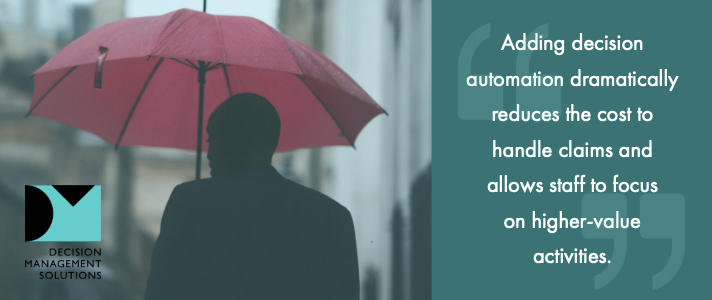To keep processing costs low, many insurance carriers have a goal to increase the percentage of their claims that can be processed and decisioned with no human decision-making involved. This is called increasing the rate of straight-through processing (STP).
Perhaps surprisingly, there remains a fair amount of human intervention involved in processing insurance claims. In many cases, staff members are challenged to gather and organize multiple data sources to determine the best decision for each customer. Manual handling of decisions also opens up a company to risks of non-compliance with industry best practices, corporate standards, and regulatory requirements. Adding decision automation dramatically reduces the cost to handle claims and allows staff to focus on higher-value activities.
Our core principles for decision management include:
Today’s businesses require digital decisions
The speed, volume and complexity of decisions – as well as the impact they have on customer experience – demand automated, real-time decision making. Decisions need to be made about products to be presented, offers, pricing, fulfillment, eligibility, and approval with speed, analytical precision and cross-channel consistency.
Focus on the decisions first
Decisions are required to complete most customer interactions. Our DecisionsFirst™ methodology ensures that decision making approaches are designed to deliver measurable business outcomes and use the right combination of data, analytic insight and business know-how. The DecisionsFirst methodology requires a shift in how organizations think about business architecture, process automation, rules analysis and analytics requirements. This shift involves:
- Beginning with the decisions themselves, not the data,
- Beginning with operational decisions, not strategic ones, and
- Beginning with an agile analytic deployment platform, not with visualization
DecisionsFirst Modeler is a collaborative decision modeling solution that combines software, the DecisionsFirst methodology, and the integration required to model and deploy operational decisions.
Mix and match the most appropriate technologies
Analytics, machine learning, artificial intelligence and business rules can be combined to complement each technology’s sweet spots and minimize the limitations of a single approach. DecisionsFirst Modeler enables the relevant mix of analytics, AI, rules, machine learning, optimization, decision support and decision automation to be applied in a single model.
Design and build a decision model
A decision model is the backbone of any decision management initiative. It is the framework for identifying, organizing, and managing the logic and analytics used to make a business decision. Decision models also manage the data needed for reporting and continuous improvement. Decision models help:
- Automate policies
- Enforce regulations
- Encapsulate expertise
- Put analytics, machine learning and AI to work
Employ machine-learning in real-time
While machine learning platforms make it easy to deploy models, employing them to improve decision-making is more complex. Using a decision model to integrate ML or AI into a rules-based decision is a critical component in effective use of ML models. The DecisionsFirst approach also uses the business rules management system (BRMS) to manage the ML model API call, linking the BRMS execution environment to a Spark Streaming environment that handles both transactions and the analytical features and aggregates required for the ML models.
Use decision services to employ the decisions
Decision services deliver digital decisions to systems. At the heart of the DecisionsFirst solutions is a powerful decision service. A decision service encapsulates business rules, predictive analytics, machine learning (ML) and artificial intelligence (AI) to deliver automated decisions to applications.
Start with a pilot or proof of approach
Start with automating and improving a single decision (such as insurance claims handling or next best offer) to demonstrate the power of Decision Management.
Focus on continuous improvement
Once the DecisionsFirst solution is implemented, clients move their focus to continuous improvement. Clients receive a dashboard on which they can simulate changes to their rules or policies prior to making those changes live, facilitating and informing the ongoing continuous improvement approach.
